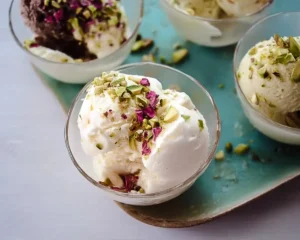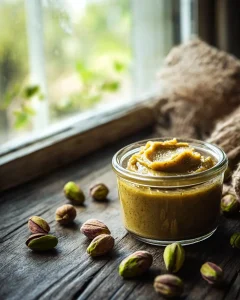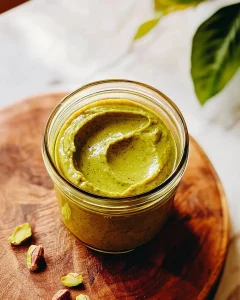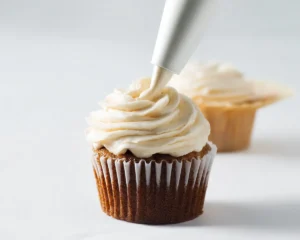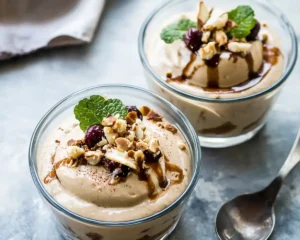Dreamy Lavender Honey Panna Cotta
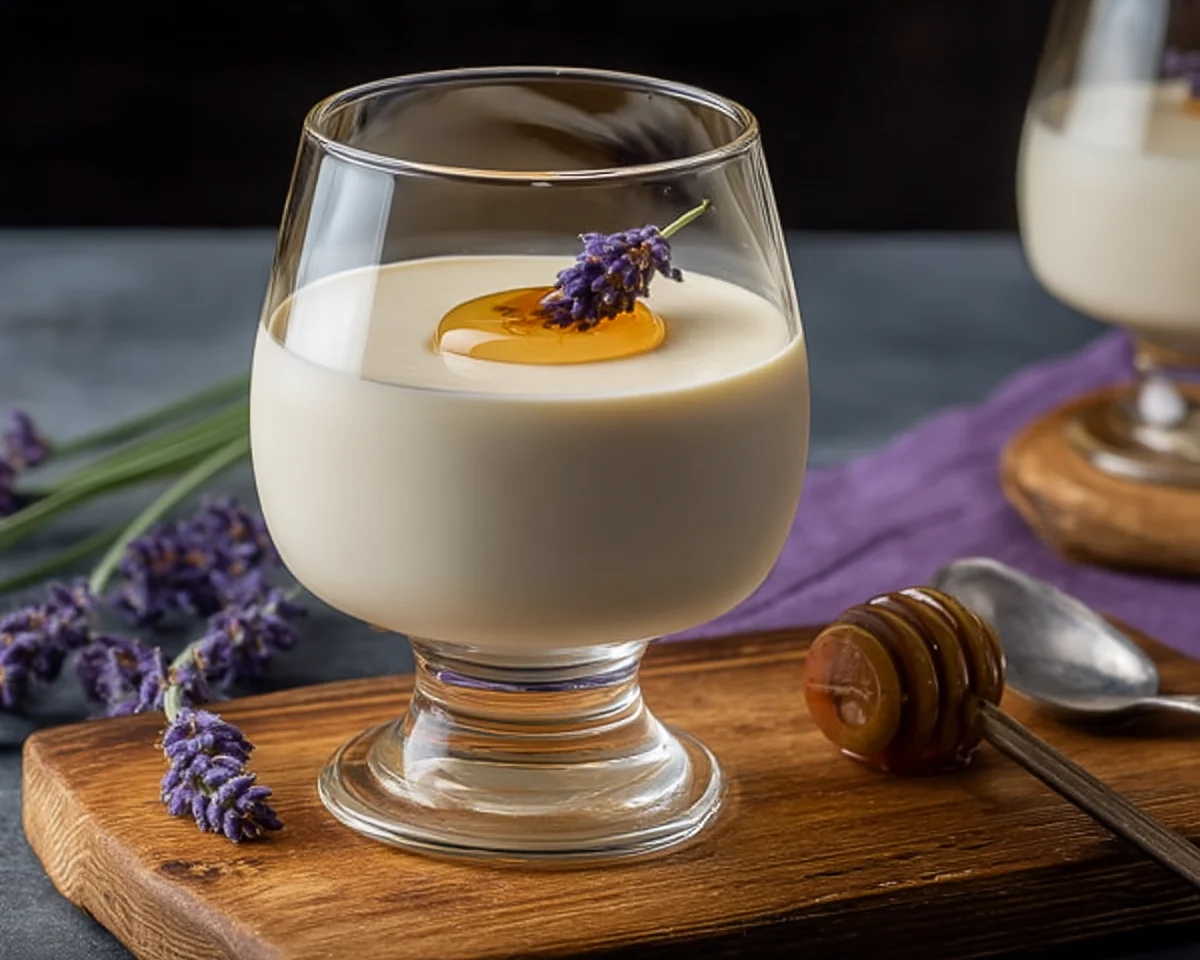
This lavender honey panna cotta is silky, floral, and naturally sweetened. A show-stopping dessert that takes just 15 minutes of hands-on time!
This lavender honey panna cotta transforms just six simple ingredients into the most ethereal, cloud-like dessert you’ll ever spoon into. The gentle floral notes from dried lavender buds dance with golden honey’s warmth, creating a dessert that tastes like a summer garden at sunset—delicate, romantic, and utterly unforgettable.
I’ll be honest—the first time I made a panna cotta with lavender and honey, I was terrified of the gelatin. Would it set? Would it wobble? Would I end up with sweet soup? But here’s the beautiful secret: this Italian no-bake wonder is actually one of the most forgiving desserts you’ll ever make.
The lavender brings this sophisticated floral whisper that never overpowers, while honey adds depth that regular sugar just can’t match. If you’re into delicate floral desserts, you’ll want to check out our ultimate elderflower panna cotta too—it’s got that same elegant vibe.
Why You’ll Love This Lavender Panna Cotta
This honey lavender panna cotta recipe is your ticket to looking like a fancy pastry chef with minimal effort. Here’s why it’ll become your go-to elegant dessert:
- Ridiculously simple: No baking, no water baths, no stress—just heat, stir, chill
- Make-ahead magic: Prep it the night before and relax when guests arrive
- Naturally gluten-free: Perfect for friends with dietary restrictions
- Elegantly understated: The floral notes are subtle, not soapy or perfume-y
- Customizable sweetness: Adjust honey to your taste without ruining the texture
I learned this recipe during a summer in Northern California when lavender fields were blooming everywhere, and honestly, I’ve never looked back. According to Bon Appétit, panna cotta is one of those desserts that improves with confidence—the more you make it, the more you understand how forgiving it really is.
Table of Contents
Nutritional Peek (Per Serving)
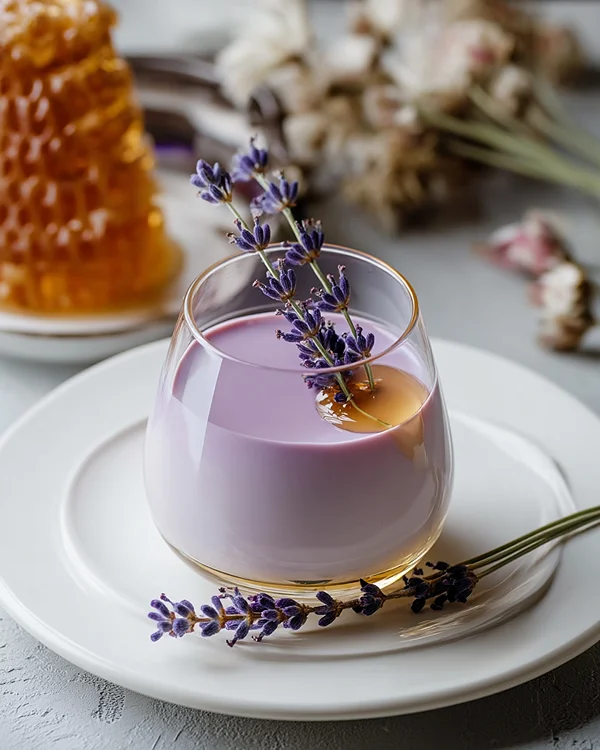
| Nutrient | Amount |
|---|---|
| Calories | 285 |
| Protein | 4g |
| Carbohydrates | 28g |
| Fat | 18g |
| Fiber | 0g |
| Sugar | 26g |
Based on 6 servings
Ingredients for Your Honey Lavender Panna Cotta Recipe
Let’s gather what you need for this honey lavender panna cotta recipe. I’ve tested this dozens of times, and these exact proportions give you that perfect spoonable-yet-firm texture.
| Amount | Ingredient | Notes |
|---|---|---|
| 2 cups | Heavy cream | This creates that signature silky richness—don’t swap for light cream |
| 1 cup | Whole milk | Balances the richness and makes it spoonable, not gummy |
| 1/2 cup | Sugar | Granulated white sugar works beautifully here |
| 2 teaspoons | Unflavored gelatin powder | One standard packet; this is your setting agent |
| 2 tablespoons | Dried lavender buds | Culinary-grade only! Craft store lavender may be treated |
| 1/4 cup | Honey | I love a light wildflower or clover honey—it’s floral without competing with lavender |
Pro ingredient tip: Make sure you’re using culinary lavender, not the stuff from the garden center. If you’re unsure where to find it, our green tea latte with whipped cream guide has a section on sourcing specialty ingredients that might help.
Equipment You’ll Need
Essential:
- Medium saucepan (about 2-3 quarts)
- Fine-mesh strainer or sieve
- Small bowl for blooming gelatin
- 6 ramekins or small serving glasses (4-6 oz each)
- Whisk
Optional but nice:
- Kitchen thermometer (to avoid boiling)
- Ladle (for neat pouring)
- Offset spatula (for unmolding if you’re feeling fancy)
Step-by-Step Instructions for Lavender Honey Panna Cotta
Making lavender honey panna cotta is all about patience and gentle heat—no rushing, just smooth, mindful steps. Here’s how we do it:
Step 1: Bloom your gelatin
Pour 3 tablespoons of cold water into a small bowl and sprinkle the gelatin evenly over the surface. Let it sit for 5 minutes—it’ll puff up and look spongy. This is called “blooming,” and it’s what keeps your panna cotta smooth instead of lumpy. Don’t skip this step!
Step 2: Infuse the lavender
In your saucepan, combine the heavy cream, whole milk, sugar, and dried lavender buds. Set the heat to medium and warm the mixture, stirring occasionally, until you see gentle steam rising and tiny bubbles forming at the edges—about 5-7 minutes. You want it hot but NOT boiling (if you’ve got a thermometer, aim for around 170°F). The kitchen will smell absolutely dreamy at this point.
Step 3: Marry gelatin and honey
Remove the pan from heat immediately. Add your bloomed gelatin and honey, then whisk gently but thoroughly until both dissolve completely—about 30-45 seconds. The mixture should look smooth and unified, with no gelatin blobs floating around.
Step 4: Strain out the lavender
Place your fine-mesh strainer over a large measuring cup or bowl with a spout. Pour the entire mixture through, pressing gently on the lavender buds with the back of a spoon to extract every bit of flavor. Toss those buds—they’ve done their job.
Step 5: Pour and chill
Carefully divide the strained mixture among your ramekins or serving glasses. If you want to unmold them later, lightly oil your ramekins first with a neutral oil on a paper towel. Otherwise, just pour and serve directly from pretty glasses. Cover each with plastic wrap (press it directly on the surface if you hate that skin that sometimes forms) and refrigerate for at least 4 hours, though overnight is even better.
Step 6: The grand reveal
If unmolding, dip the bottom of each ramekin in warm water for 3-5 seconds, run a thin knife around the edge, and invert onto a plate—give it a little shake and it’ll release with a satisfying thwoop. Drizzle with extra honey, maybe add a tiny lavender sprig or fresh berries, and watch everyone’s eyes light up.
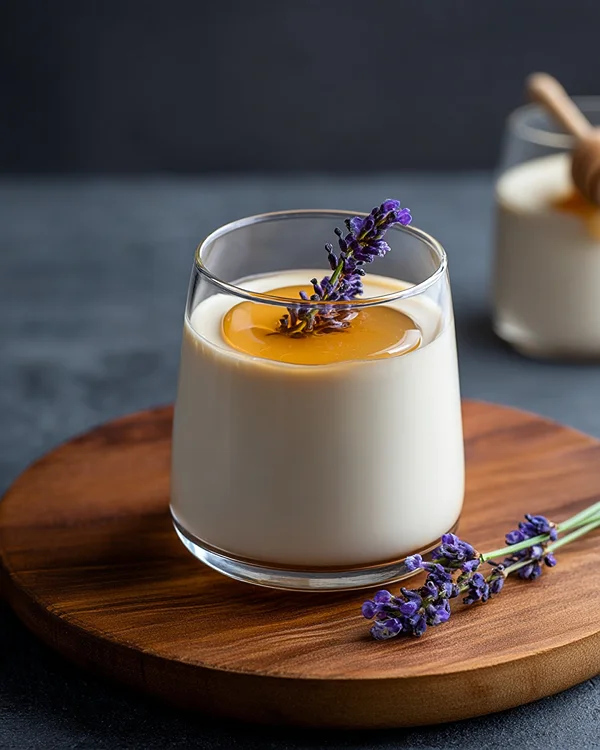
Pro Tips & Guidance for Perfect Panna Cotta
This panna cotta with lavender and honey deserves a few insider tricks I’ve learned through trial (and a couple errors):
On lavender intensity: Start with 2 tablespoons if you’re new to cooking with lavender. You can always add a bit more next time, but too much can taste soapy. I learned this the hard way at a dinner party—oops.
The wobble test: A properly set panna cotta should jiggle when you gently shake the ramekin, kind of like a just-set Jell-O but way more sophisticated. If it’s too firm, reduce gelatin by 1/4 teaspoon next time; if it’s too loose, add a bit more.
Temperature matters: Never let your cream mixture boil, or you risk a grainy texture and the gelatin might not set properly. According to King Arthur Baking, gentle heat is the secret to all dairy-based custards and creamy desserts.
Flavor layering: The honey you choose for your Lavender Honey Panna Cotta genuinely changes the final taste. Buckwheat honey brings earthiness, orange blossom adds citrus notes, and acacia is super mild and floral.
Troubleshooting Guide
Problem: My panna cotta won’t set
No worries! This usually means the gelatin didn’t bloom properly or the mixture got too hot. Next time, make sure your gelatin sits for the full 5 minutes and don’t let that cream boil. You can actually re-warm a too-loose panna cotta, add a tiny bit more dissolved gelatin, and re-chill it.
Problem: It tastes too floral or soapy
Lavender can be intense! If this happens, serve with fresh berries or a berry compote to balance it. Next batch, cut the lavender back to 1 tablespoon.
Problem: There are lumps in my panna cotta
This means gelatin clumped when added. Make sure you bloom it properly and that your cream mixture is hot enough (but not boiling) to fully dissolve it. Whisk vigorously when adding.
Problem: It won’t unmold
The warm water dip wasn’t long enough, or you didn’t run a knife around the edge. Try again—or honestly, serving it in pretty glasses is just as gorgeous and way less stressful!
Variations & Twists on Lavender Panna Cotta
Once you’ve mastered the classic lavender panna cotta, the world opens up:
Seasonal swaps:
- Spring: Add lemon zest to the cream for lavender-lemon bliss
- Summer: Top with macerated strawberries and a basil leaf
- Fall: Swap lavender for Earl Grey tea and serve with poached pears
- Winter: Add a vanilla bean and top with pomegranate seeds
Dairy-free version: Use full-fat coconut cream (the thick stuff from the top of the can) and coconut milk. It’ll have a subtle tropical note that’s actually lovely with lavender.
Layered presentation: Make a berry compote, pour it into glasses first, chill for 30 minutes, then add the panna cotta mixture on top for a gorgeous layered effect.
If you’re into exploring floral flavors, definitely check out our ultimate lavender panna cotta recipe for another stunning variation.
Serving, Storage & Reheating
Serving suggestions: This honey lavender panna cotta recipe shines with minimal fuss. Drizzle with extra honey, add fresh berries, or scatter a few edible flowers for that Instagram-worthy moment. I love serving it with shortbread cookies or delicate almond tuiles on the side.
Storage: Keep covered in the fridge for up to 4 days. The texture might firm up slightly over time, but the flavor actually deepens beautifully.
Can you freeze it? Technically yes, but I don’t recommend it—the texture gets grainy when thawed. This is a make-ahead-by-a-day-or-two dessert, not a make-ahead-by-a-month one.
No-Waste Kitchen Magic
Don’t toss those used lavender buds just yet! Here’s how to give them a second life:
- Lavender simple syrup: Simmer the strained buds with equal parts sugar and water for 10 minutes, strain again, and you’ve got flavored syrup for cocktails or lemonade
- Tea blend: Dry the buds on a paper towel and mix with chamomile for a calming bedtime tea
- Drawer sachets: Let them dry completely and tuck into small cloth bags for naturally fragrant drawer fresheners
And that leftover honey? Drizzle it on your morning yogurt or oatmeal, or use it to sweeten tea. Nothing goes to waste in a mindful kitchen!
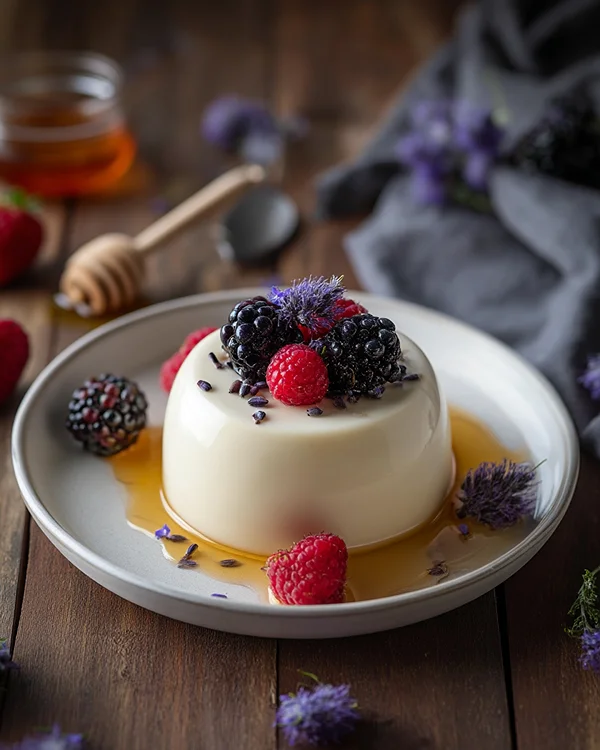
FAQs About Lavender Honey Panna Cotta
Can I freeze lavender honey panna cotta?
While you technically can freeze it for up to a month, I don’t recommend it. The gelatin texture becomes grainy and weepy when thawed. Panna cotta is best enjoyed fresh or within 3-4 days of making.
How do I know if my panna cotta has set properly?
After 4 hours in the fridge, give the ramekin a gentle shake. Your panna cotta should wobble uniformly like a soft custard but hold its shape. If it’s still liquid in the center, give it another hour or two.
Where can I buy culinary lavender buds?
Look for food-grade lavender at specialty stores, Whole Foods, online at Amazon, or spice shops like The Spice House. Make sure the label says “culinary” or “food grade”—craft store lavender may contain pesticides.
Can I make this dairy-free?
Absolutely! Substitute canned coconut cream and coconut milk in the same proportions. The coconut flavor pairs surprisingly well with lavender and honey. Just make sure your coconut cream is full-fat for the best texture.
What’s the best honey to use for panna cotta with lavender and honey?
Light, floral honeys work beautifully here—think clover, wildflower, or acacia. Avoid strong honeys like buckwheat unless you really love intense flavors. The honey should complement, not compete with, the lavender.
Help! My panna cotta tastes too much like soap!
This happens when there’s too much lavender or it steeped too long. Cut back to 1-1.5 tablespoons next time, and don’t let the cream simmer for more than 7-8 minutes. Serve the current batch with sweet berries to balance the flavor.
Your New Signature Dessert Awaits
There you have it—your complete guide to making the most elegant, crowd-pleasing lavender honey panna cotta that tastes like you trained at a French patisserie (but took maybe 15 minutes of actual work). The beauty of this dessert is how it looks impressive but feels effortless, making you the relaxed, confident host everyone wants to be.
I’d absolutely love to see your creations! Share your panna cotta photos in the comments below, and tell me—did you try any fun variations? Did you unmold them or serve them in glasses? And if you’re craving more delicate, special-occasion desserts, don’t miss our collection of show-stoppers.
Happy dessert making, friends! May your panna cottas wobble perfectly and your kitchen smell like a Provence lavender field.

Lavender Honey Panna Cotta
Ingredients
Equipment
Method
- Pour 3 tablespoons of cold water into a small bowl and sprinkle the gelatin evenly over the surface. Let it sit for 5 minutes—it’ll puff up and look spongy. This is called blooming, and it’s what keeps your panna cotta smooth instead of lumpy.
- In your saucepan, combine the heavy cream, whole milk, sugar, and dried lavender buds. Set the heat to medium and warm the mixture, stirring occasionally, until you see gentle steam rising and tiny bubbles forming at the edges—about 5-7 minutes. You want it hot but NOT boiling (if you’ve got a thermometer, aim for around 170°F).
- Remove the pan from heat immediately. Add your bloomed gelatin and honey, then whisk gently but thoroughly until both dissolve completely—about 30-45 seconds. The mixture should look smooth and unified, with no gelatin blobs floating around.
- Place your fine-mesh strainer over a large measuring cup or bowl with a spout. Pour the entire mixture through, pressing gently on the lavender buds with the back of a spoon to extract every bit of flavor. Toss those buds—they’ve done their job.
- Carefully divide the strained mixture among your ramekins or serving glasses. If you want to unmold them later, lightly oil your ramekins first with a neutral oil on a paper towel. Cover each with plastic wrap and refrigerate for at least 4 hours, though overnight is even better.
- If unmolding, dip the bottom of each ramekin in warm water for 3-5 seconds, run a thin knife around the edge, and invert onto a plate. Drizzle with extra honey, maybe add a tiny lavender sprig or fresh berries, and serve.

